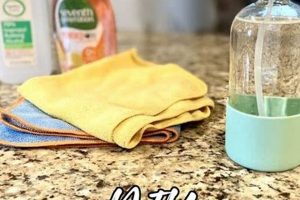A structure comprised of vertical supports connected by rungs, typically crafted at home, designed for the purpose of neatly organizing and displaying textiles. An example involves using repurposed wooden planks and dowels to construct a decorative piece for a living room, allowing blankets to be readily accessible while contributing to the aesthetic of the space.
This solution offers a dual benefit: space optimization and visual appeal. It provides an alternative to storing throws in baskets or folded on shelves, thereby reducing clutter and enhancing room organization. Historically, similar designs have been employed in various cultures to store linens and other household fabrics, reflecting a long-standing need for efficient textile management.
The following sections will delve into specific materials suitable for construction, step-by-step building instructions, customization techniques for diverse interior styles, and safety considerations for ensuring structural integrity and preventing accidents.
Construction Guidance
The following provides important advice to guarantee the creation of a safe and visually appealing storage item.
Tip 1: Material Selection: Choose wood types based on durability and aesthetic preference. Hardwoods, such as oak or maple, offer superior strength for weight-bearing, while softwoods like pine are more economical but require careful finishing. Consider reclaimed lumber for an environmentally conscious approach.
Tip 2: Precise Measurements: Accurate dimensions are crucial. Prior to cutting any materials, meticulously measure the available space and desired ladder height. Ensure the rungs are spaced evenly and at a comfortable distance to accommodate the size of the folded textiles.
Tip 3: Secure Joinery: The integrity of the joints is paramount for safety. Employ robust joinery techniques, such as mortise and tenon, dowel joints, or pocket screws, coupled with wood glue designed for high-strength bonds. Reinforce joints with metal brackets where necessary.
Tip 4: Proper Sanding and Finishing: Prior to assembly, thoroughly sand all wood surfaces to remove splinters and create a smooth finish. Apply a sealant or stain to protect the wood from moisture and enhance its appearance. Consider multiple coats of polyurethane for added durability.
Tip 5: Weight Distribution Considerations: Design the ladder to adequately distribute the weight of the textiles. Wider rungs and a stable base contribute to load-bearing capacity. Periodically inspect the structure for signs of stress or weakening.
Tip 6: Wall Anchoring (Optional): For added stability, particularly in households with children or pets, consider anchoring the ladder to a wall using appropriate hardware. Ensure the anchors are securely fastened to both the wall and the ladder frame.
Effective adherence to these guidelines will result in a functional and decorative element that enhances room organization while providing reliable support for textiles.
The succeeding section transitions into methods for customization and integration within various interior design schemas.
1. Material Durability
The longevity and functionality of a constructed storage solution are directly contingent upon the intrinsic properties of the materials selected. When constructing a textile organizer, the choice of material dictates its capacity to withstand continuous use, environmental factors, and the weight of the textiles it supports. A construction employing inherently weak or improperly treated components will exhibit premature failure, rendering the item unusable and potentially hazardous. For instance, untreated softwood exposed to high humidity is susceptible to warping and rot, compromising the structural integrity of the entire unit and potentially causing the textiles to fall.
The selection process should prioritize materials known for their resistance to stress, moisture, and insect infestation. Hardwoods such as oak, maple, and walnut offer superior durability compared to softwoods like pine or fir. Proper treatment with preservatives, sealants, or finishes further enhances the material’s ability to withstand environmental stressors. The use of reclaimed wood, while aesthetically appealing, necessitates a thorough inspection to ensure the absence of pre-existing damage or degradation that could compromise its structural integrity. Ignoring material durability can result in costly repairs, replacement, and a diminished lifespan for the storage solution.
In conclusion, the correlation between material durability and the long-term effectiveness of the project is undeniable. The investment in high-quality, appropriately treated materials directly translates to a reliable and aesthetically pleasing storage solution capable of withstanding the demands of daily use. Neglecting this critical aspect undermines the entire project, leading to potential safety hazards and a shortened lifespan for the constructed piece.
2. Structural Integrity
Structural integrity represents a critical consideration when undertaking the construction of a textile storage unit. Its significance extends beyond mere aesthetics, directly impacting the safety and longevity of the finished product. A poorly constructed piece presents potential hazards, necessitating a thorough understanding of fundamental engineering principles.
- Joint Strength and Stability
The method by which individual components are joined dictates the overall stability of the structure. Weak joints, such as those inadequately glued or poorly fastened, are prone to failure under stress. Examples include mortise and tenon joints, dowel joints, or the use of screws and bolts with appropriate load-bearing capacity. Insufficient joint strength can lead to collapse, particularly when supporting the weight of multiple textiles. The selection of appropriate joinery techniques is therefore paramount for maintaining structural soundness.
- Material Load-Bearing Capacity
Each material possesses a specific capacity to withstand weight and pressure. Exceeding this limit leads to deformation, cracking, or outright breakage. When selecting wood, consider its density and inherent strength. For instance, hardwoods generally offer superior load-bearing capacity compared to softwoods. A ladder constructed from undersized or weakened lumber may buckle under the weight of the blankets, posing a safety risk. Proper material selection ensures the structure can safely support the intended load.
- Weight Distribution and Balance
The manner in which weight is distributed across the structure influences its stability. Uneven weight distribution creates stress points, potentially leading to failure. A ladder with unevenly spaced rungs or an unstable base is prone to tipping, especially when loa
ded with textiles. A wide, stable base and evenly spaced rungs contribute to balanced weight distribution, minimizing stress and enhancing overall stability. Proper design and construction techniques mitigate the risk of imbalance and subsequent structural failure. - Resistance to External Forces
The structure must withstand forces beyond the weight of the textiles, including accidental bumps, leans, or environmental factors such as humidity. Inadequate bracing or flimsy construction renders the unit susceptible to damage from external forces. Reinforcing joints with metal brackets or employing a sturdy design enhances resistance to these forces, extending the lifespan and ensuring continued safe operation. Consideration of potential external stressors is crucial for long-term structural integrity.
These elements collectively contribute to the structural integrity of the completed project. Without careful consideration of joint strength, material load-bearing capacity, weight distribution, and resistance to external forces, the storage unit may become a safety hazard and fail to fulfill its intended purpose. These aspects are paramount to the safe and successful outcome of the endeavor.
3. Design Aesthetics
The aesthetic qualities of a self-constructed textile storage apparatus directly influence its integration within a given interior space. The visual characteristics, encompassing form, color, and material, determine whether the item functions as a complementary element or a disruptive presence. A design that disregards prevailing stylistic cues risks undermining the cohesive nature of the environment. For example, a roughly hewn ladder constructed from unfinished lumber may appear incongruous within a minimalist, modern living room characterized by clean lines and neutral tones, thereby detracting from the overall aesthetic appeal.
Conversely, a meticulously crafted ladder featuring a refined silhouette, a carefully selected stain, and subtle hardware can serve as a focal point, enhancing the visual interest of the space. The chosen design should reflect and amplify the existing decor. A rustic farmhouse interior might benefit from a ladder incorporating distressed wood and wrought iron accents, while a bohemian-inspired setting could accommodate a ladder painted in vibrant colors or adorned with macrame detailing. The practical application of this understanding lies in the ability to tailor the construction to seamlessly blend with, or deliberately contrast against, the established design scheme.
In summary, the aesthetic dimension of the textile holding solution is not merely an ornamental consideration; it is an integral factor in achieving visual harmony and enhancing the overall ambiance of a room. The challenge resides in balancing functional requirements with aesthetic sensibilities, ensuring that the final product serves both a practical purpose and contributes positively to the designed environment. Failure to acknowledge this interconnectedness results in a piece that, while functional, lacks the visual appeal necessary to become an integrated element of the home.
4. Space Optimization
Space optimization, in the context of domestic interiors, refers to the efficient and effective utilization of available area to maximize functionality and minimize clutter. The integration of specifically designed storage solutions directly addresses the need for improved spatial management, particularly within constrained living environments. A vertically oriented structure for textile storage exemplifies this principle, allowing for organization without occupying significant floor space.
- Vertical Expansion
Vertical expansion capitalizes on unused vertical space, transforming it into usable storage. A standard bookshelf provides a clear example, using height to house multiple items within a minimal footprint. In the instance of a constructed textile management piece, the rungs extend upwards, providing storage for multiple textiles without consuming valuable horizontal area, crucial in smaller living spaces.
- Footprint Reduction
Minimizing the surface area consumed by storage solutions is a primary objective of effective space optimization. Traditional blanket chests, while providing substantial storage capacity, require a significant horizontal area. A vertically oriented textile holding structure, however, utilizes a smaller footprint, freeing up floor space for other furniture or activities. This reduction is particularly advantageous in apartments or smaller homes where every square foot is valuable.
- Accessibility Enhancement
Effective space optimization also considers the ease of access to stored items. Overly complex or deeply packed storage systems can negate the benefits of space-saving designs if retrieving an item requires significant effort or disrupts the organization of other items. A vertically oriented textile holder provides easy visibility and access to individual textiles, streamlining the retrieval process and promoting organized storage habits. This simple accessibility is an integral aspect of effective space management.
- Multifunctional Design
The concept of multifunctional design further enhances space optimization by integrating multiple uses into a single structure. For example, a textile storage structure can serve as a decorative element, enhancing the aesthetic appeal of a room while simultaneously providing practical storage. The use of reclaimed wood or custom finishes allows the piece to blend seamlessly with the existing decor, further optimizing the use of space and resources by combining storage and aesthetic functions.
The aforementioned facets highlight the interconnectedness of effective space optimization and a vertically oriented textile holding structure. By leveraging vertical space, minimizing the occupied footprint, enhancing accessibility, and embracing multifunctional design principles, this organizational method provides a compelling solution for efficient management of textiles within a limited spatial environment. This translates to a more organized, functional, and visually appealing living space.
5. Textile Accessibility
Textile accessibility, defined as the ease and efficiency with which textiles can be retrieved and stored, is a primary functional consideration in the design and implementation of a do-it-yourself blanket ladder. The efficacy of this storage solution hinges on its capacity to facilitate convenient access to and organization of blankets, throws, and other fabric items.
- Visual Inventory Management
The open design afforded by a ladder construction promotes immediate visual assessment of available textiles. Unlike enclosed storage options such as chests or cupboards, a blanket ladder displays its contents openly, allowing for rapid identification of desired items. This visual inventory management reduces the time and effort required to locate a specific blanket, contributing to enhanced accessibility and efficient use of stored materials.
- Unrestricted Retrieval
The horizont
al rungs of a ladder provide unobstructed access to each textile. Items can be easily removed without disturbing adjacent articles, preventing the cascade effect often experienced with stacked or piled storage methods. This unrestricted retrieval capability ensures that desired blankets can be accessed quickly and without the need to reorganize the entire collection, furthering the overall ease of use. - Simplified Restorage
The same open design that facilitates easy retrieval also simplifies the process of restorage. Blankets can be draped over the rungs with minimal effort, eliminating the need for complex folding or stacking procedures. This simplified restorage encourages consistent organization and prevents the accumulation of disorganized textiles, maintaining the accessibility and aesthetic appeal of the ladder.
- Adaptable Height and Spacing
A significant advantage of the do-it-yourself approach is the ability to customize the height and spacing of the rungs to accommodate specific textile sizes and organizational preferences. This adaptability allows for tailoring the ladder to the precise needs of the user, optimizing both storage capacity and ease of access. For instance, wider spacing between rungs may be preferred for thicker blankets, while narrower spacing can accommodate thinner throws or scarves, thus maximizing functionality.
In summary, the intrinsic design characteristics of a do-it-yourself blanket ladder inherently enhance textile accessibility. The open display, unrestricted retrieval, simplified restorage, and adaptable configuration options combine to create a storage solution that prioritizes convenience and organization, ensuring that textiles are readily available and efficiently managed within the living space.
Frequently Asked Questions
The following addresses prevalent inquiries regarding the construction and implementation of a do-it-yourself ladder intended for textile storage, providing concise and informative responses to ensure clarity and mitigate potential challenges.
Question 1: What wood type is most suitable for a construction designed for textile support?
Hardwoods such as oak, maple, or walnut offer superior strength and durability for supporting textile weight. Softwoods like pine are acceptable, but require proper sealing and reinforcement to prevent warping or breakage. The choice depends on budget and aesthetic preference, balancing cost with structural integrity.
Question 2: How does one ensure the structural stability of a hand-built textile organization structure?
Structural stability is achieved through robust joinery techniques, such as mortise and tenon or dowel joints, coupled with high-strength wood glue. Reinforcing joints with metal brackets is advisable, particularly for heavier textiles. Proper weight distribution and a stable base are also critical for preventing tipping or collapse.
Question 3: What safety precautions should be observed during the construction process?
Eye protection and respiratory masks are essential when cutting or sanding wood. A well-ventilated workspace minimizes exposure to dust and fumes. Secure clamping of materials before cutting prevents slippage and injury. Adherence to manufacturer instructions for power tools and adhesives minimizes the risk of accidents.
Question 4: How can a textile holding structure be customized to match existing decor?
Customization options include selecting wood stains or paints that complement the room’s color palette. Decorative hardware, such as unique knobs or brackets, adds visual interest. Incorporating design elements such as distressing, carving, or stenciling allows for further personalization. The design should integrate seamlessly with the established aesthetic.
Question 5: Is anchoring the structure to a wall necessary, and if so, how is it accomplished?
Anchoring to a wall provides added stability, particularly in homes with children or pets. Use appropriate wall anchors and screws based on wall construction (drywall, plaster, or masonry). Locate wall studs for secure attachment. Ensure the ladder is positioned level before anchoring to prevent stress on the structure.
Question 6: What is the optimal spacing between rungs for efficient storage of average-sized blankets?
A rung spacing of 10-12 inches typically accommodates average-sized blankets. Adjust spacing based on blanket thickness; thicker blankets require wider spacing. Ensure adequate clearance between the blankets and the floor to prevent dragging or snagging.
Key takeaways include prioritizing structural integrity, adhering to safety guidelines, and customizing the design to complement existing decor. Thoughtful planning and execution ensure a functional and aesthetically pleasing storage solution.
The subsequent section will detail advanced design considerations for a project.
Conclusion
This exposition has detailed the construction and customization of the “diy ladder for blankets” storage solution. It has underscored the imperative nature of material selection, structural integrity, design aesthetics, space optimization, and textile accessibility when undertaking such a project. The preceding exploration has provided comprehensive guidance on ensuring both the functionality and the visual integration of this organizational tool within diverse domestic environments.
The successful implementation of a “diy ladder for blankets” hinges on a commitment to precision and a thorough understanding of the principles outlined herein. Thoughtful application of these guidelines will yield not only an efficient storage solution but also a distinctive element of interior decor, thereby enhancing both the utility and the aesthetic value of the living space. The enduring benefit of this endeavor lies in its capacity to transform clutter into organized elegance, ultimately contributing to a more harmonious and functional home.







